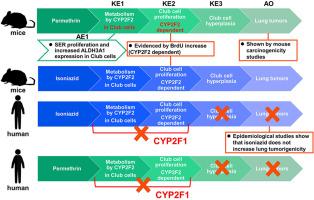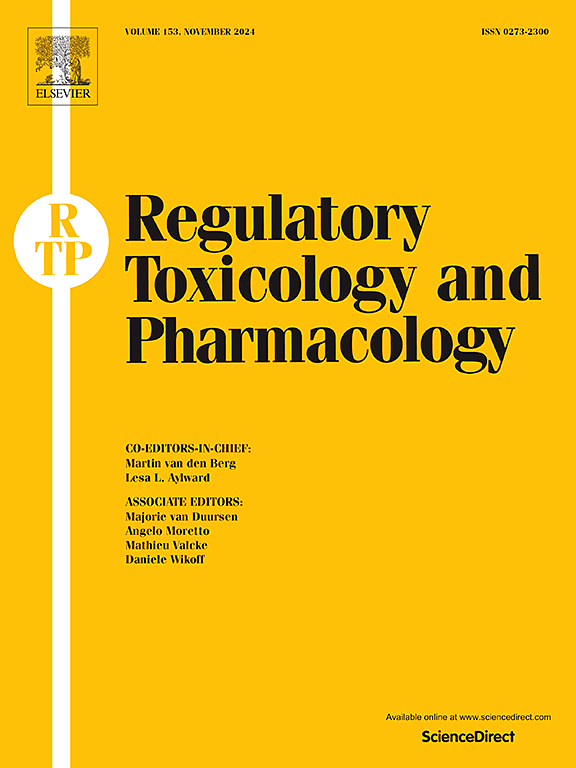Mode of action analysis for induction of mouse lung tumors by permethrin: Involvement of CYP2F2 enzyme and human relevancy
IF 3.5
4区 医学
Q1 MEDICINE, LEGAL
引用次数: 0
Abstract
Permethrin increases the incidence of bronchiolo-alveolar adenomas in female mice. The proposed mode of action (MOA) for permethrin-induced lung tumorigenesis involves increased mitogenesis in Club cells. Additionally, CYP2F2, which is particularly expressed in mouse lung Club cells and different from human CYP2F1, is considered to be a key factor in mouse-specific lung tumorigenesis. In this study, we investigated the relationship between permethrin-induced mouse lung tumorigenesis and CYP2F2 in CYP2f2 knockout (KO) mice. Fluensulfone and isoniazid were selected as positive controls. We showed that the increased proliferation of Club cells and increased proliferation of smooth endoplasmic reticulum (SER) within them were abolished in permethrin-treated CYP2f2 KO mice, while these changes were clearly observed in permethrin- and positive control-treated wild type mice. Additionally, the disappearance of the Club cell reaction was also observed in positive control-treated CYP2f2 KO mice. Based on these results, it was concluded that CYP2F2 is essential in the MOA of mouse lung tumorigenesis by permethrin, also suggesting that permethrin metabolism by CYP2F2 corresponds to a chain of early key events, including the molecular initiating event (MIE). Furthermore, the data suggested that CYP2F2 played a crucial role in mouse lung tumorigenesis induced by isoniazid, which is known to cause lung tumors in mice but not in humans. The collective data on permethrin-treated mouse lung tumorigenesis, including findings from this study, would lead to the conclusion that the lung tumors induced by permethrin treatment are mouse-specific and not relevant to human lung cancer risk.

氯菊酯诱导小鼠肺肿瘤的作用模式分析:CYP2F2酶的参与与人的相关性。
氯菊酯增加雌性小鼠细支气管肺泡腺瘤的发病率。氯菊酯诱导肺肿瘤发生的作用模式(MOA)涉及俱乐部细胞有丝分裂的增加。此外,与人CYP2F1不同,CYP2F2在小鼠肺俱乐部细胞中特别表达,被认为是小鼠特异性肺肿瘤发生的关键因素。在本研究中,我们研究了氯菊酯诱导的小鼠肺肿瘤发生与CYP2F2敲除(KO)小鼠的CYP2F2之间的关系。阳性对照选用氟砜和异烟肼。我们发现,在氯菊酯处理的CYP2f2 KO小鼠中,俱乐部细胞增殖的增加和细胞内光滑内质网(SER)增殖的增加被消除,而这些变化在氯菊酯处理和阳性对照的野生型小鼠中被清楚地观察到。此外,在阳性对照处理的CYP2f2 KO小鼠中也观察到俱乐部细胞反应的消失。综上所述,CYP2F2在氯菊酯致小鼠肺肿瘤发生的MOA中起重要作用,并提示CYP2F2代谢氯菊酯的早期关键事件包括分子启动事件(MIE)。此外,数据表明CYP2F2在异烟肼诱导的小鼠肺肿瘤发生中起着至关重要的作用,已知异烟肼在小鼠中引起肺肿瘤,但在人类中没有。氯菊酯处理小鼠肺肿瘤发生的总体数据,包括本研究的发现,将得出结论,氯菊酯处理诱导的肺肿瘤是小鼠特异性的,与人类肺癌风险无关。
本文章由计算机程序翻译,如有差异,请以英文原文为准。
求助全文
约1分钟内获得全文
求助全文
来源期刊
CiteScore
6.70
自引率
8.80%
发文量
147
审稿时长
58 days
期刊介绍:
Regulatory Toxicology and Pharmacology publishes peer reviewed articles that involve the generation, evaluation, and interpretation of experimental animal and human data that are of direct importance and relevance for regulatory authorities with respect to toxicological and pharmacological regulations in society. All peer-reviewed articles that are published should be devoted to improve the protection of human health and environment. Reviews and discussions are welcomed that address legal and/or regulatory decisions with respect to risk assessment and management of toxicological and pharmacological compounds on a scientific basis. It addresses an international readership of scientists, risk assessors and managers, and other professionals active in the field of human and environmental health.
Types of peer-reviewed articles published:
-Original research articles of relevance for regulatory aspects covering aspects including, but not limited to:
1.Factors influencing human sensitivity
2.Exposure science related to risk assessment
3.Alternative toxicological test methods
4.Frameworks for evaluation and integration of data in regulatory evaluations
5.Harmonization across regulatory agencies
6.Read-across methods and evaluations
-Contemporary Reviews on policy related Research issues
-Letters to the Editor
-Guest Editorials (by Invitation)

 求助内容:
求助内容: 应助结果提醒方式:
应助结果提醒方式:


